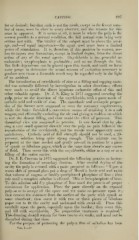Page 887 - My FlipBook
P. 887
CAPPING. 897
for or desired ; but that sucli is not the result, except in the fewest num-
ber of cases, must be clear to every observer, and the reasons for this
must be apparent. If it occurs at all, it must be where the pulp is the
nearest possible to a normal condition, the full normal state being very
seldom met with. The vitality of the subject must be above the aver-
age, and—of equal importance—the agent used must have a limited
power of stimulation. It is, therefore, if this position be correct, use-
less to expect ncM' formations, except in limited degree, from the direct
action of any of the usual agents. Oxychloride is too powerful an
escharotic ; oxyphosphate is preferable ; and so on through the list.
But little dependence can be placed upon this result, and until we have
some gauge to determine the actual amount of excitation necessary to
produce new tissue a favorable result may be regarded only in the light
of an accident.
The introduction of oxychloride of zinc as a filling and capping mate-
rial M'as naturally followed by investigation in other directions; efforts
were made to avoid the direct injurious escharotic effect of this and
other valuable agents. Dr. J. S. King in 1871 suggested covering the
pulp, prior to the insertion of the oxychloride, with a paste made of
carbolic acid and oxide of zinc. The anaesthetic and antiseptic proper-
ties of the former were su])posed to meet the necessary requirements,
while the latter furnished a convenient means of retaining it in a soft
magma, and effectually excluding the air and giving a cushion on which
to rest the denser filling, and thus avoid the effect of pressure. This
theoretical view was sustained in practice. It was found that by pla-
cing a very small quantity directly over the pulp no pain folloMcd the
introduction of the oxychloride, and the results were apparently more
satisfactory. Carbolic acid of full stroigth should not be used, a 20-
per-cent. solution being quite strong enough. This mixture can be
prepared at the time needed and gently pressed in position by a piece
of spunk or bibulous pa])er, which at the same time absorbs any excess
of fluid. Then cover this with the oxychloride, either as a cap or as a.
filling of the entire cavity.
Dr. J. E. Cravens in 1873 suggested the following practice as hasten-
ing the formation of secondary dentine. After careful drying of the
cavity the pulp is covered \vith a jiaste prepared as follows : '' Upon a
warm slab of ground glass put a drop of Merck's lactic acid and twice
that volume of magma or freshly-precipitated phosphate of lime ; then
rub until a complete solution is effected. This is laetophosphate of lime.
To this solution add dry phosphate of lime until the paste is of i)roper
consistence for application. Place the paste directly on the exposed
pulp so as to occupy all the space and yet make no pressure upon it ;-.
then remove the moisture from the surface of the paste with spunk or
some absorbent; then cover it with two or three pieces of bibulous
paper cut to fit the cavity and moistened with sweet oil. Press this
carefully upon the paste, especially upon the border ; then cover this,
and fill with oxychloride. No preparative treatment is required."
This dressing should remain for from two to six weeks, and must not be
disturbed during that time.
For the purpose of protecting the pulp a film of collodion has been
Vol. I.—57


